|
Snapshots 61-75
John Davis, a Dothan ( Alabama) entrepreneur, sells a variety of products on his 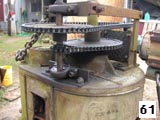 corner. Of particular interest is fresh-squeezed sugar-cane juice, which is available for several months from cane that he banks in hay under a shed. For squeezing the cane, he has mechanized a Goldens' No. 3 (New Model) (Slide 61; see also) in a unusual three-reduction system. The first reduction is a speed reducer and the final two reductions are with ANSI 50 chain drives, providing slightly less than 3 rpm from a 1.5 HP motor. This design permits squeezing one line of cane. John also sells mills and had a variety available the day that I visited him (a mechanized Columbus vertical mill; an Excelsior Pony, a vertical Chattanooga mill, and a Goldens' No. 27 (New Model)). corner. Of particular interest is fresh-squeezed sugar-cane juice, which is available for several months from cane that he banks in hay under a shed. For squeezing the cane, he has mechanized a Goldens' No. 3 (New Model) (Slide 61; see also) in a unusual three-reduction system. The first reduction is a speed reducer and the final two reductions are with ANSI 50 chain drives, providing slightly less than 3 rpm from a 1.5 HP motor. This design permits squeezing one line of cane. John also sells mills and had a variety available the day that I visited him (a mechanized Columbus vertical mill; an Excelsior Pony, a vertical Chattanooga mill, and a Goldens' No. 27 (New Model)).
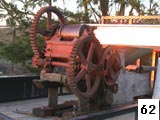 Morris Bitzer, the indefatigable Executive Secretary of the NSSPPA, puts on demonstration cook-offs using this unidentified trailer-mounted small horizontal mill (Slide 62). Although the name was not cast on the outside of the mill, the foundry gave plenty of advice. An unusual aspect of this mill is the absence of a solid side plate, but it is otherwise similar to the Southern Plow (and copies) and the Excelsior Pony. Other views of this mill can be seen by clicking here or here. Morris Bitzer, the indefatigable Executive Secretary of the NSSPPA, puts on demonstration cook-offs using this unidentified trailer-mounted small horizontal mill (Slide 62). Although the name was not cast on the outside of the mill, the foundry gave plenty of advice. An unusual aspect of this mill is the absence of a solid side plate, but it is otherwise similar to the Southern Plow (and copies) and the Excelsior Pony. Other views of this mill can be seen by clicking here or here.
William E. Myer, records of whom can be found from the late 1800s through the firs t quarter of the 1900s, took over a department store in Carthage (Tennessee) from his father, Joseph (1833-1899), and ran it until he retired in 1915. The store offered a range of merchandise, including this Myer Perfection Mill No. 1 (Slide 63), as indicated by the bolt-on plate. This mill appears to be similar if not identical to one of the larger Kentucky Blue Grass mills and is different from the Spotless Perfection mill. The most likely explanation is that Myer had a foundry make this mill for him. Myer also contributed to archeology and was Special Archaeologist for the Smithsonian Institution in his retirement. Apparently a Renaissance Man, Myer published on the pearl fisheries in Tennessee, in which broader industry his brother Herman traded. (Thanks to Al Fuqua for allowing me to examine this mill. Special thanks to Donald Ball for corrections and additional information, some of which has been used to improve this narrative.) t quarter of the 1900s, took over a department store in Carthage (Tennessee) from his father, Joseph (1833-1899), and ran it until he retired in 1915. The store offered a range of merchandise, including this Myer Perfection Mill No. 1 (Slide 63), as indicated by the bolt-on plate. This mill appears to be similar if not identical to one of the larger Kentucky Blue Grass mills and is different from the Spotless Perfection mill. The most likely explanation is that Myer had a foundry make this mill for him. Myer also contributed to archeology and was Special Archaeologist for the Smithsonian Institution in his retirement. Apparently a Renaissance Man, Myer published on the pearl fisheries in Tennessee, in which broader industry his brother Herman traded. (Thanks to Al Fuqua for allowing me to examine this mill. Special thanks to Donald Ball for corrections and additional information, some of which has been used to improve this narrative.)
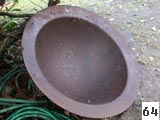 In 1835, Frost Horton and Truman Miner established a foundry in Peekskill (NY) under the name of Miner & Horton. Five years later, they took in a partner, George Depew, and operated under the name of Miner, Horton & Co. until 1859, when Miner retired and the company’s name was changed. The firm manufactured primarily agricultural equipment, this kettle being among their output. Cast between 1839 and 1859, this 30-gallon kettle (Slide 64) is the oldest “New York Pattern” kettle with foundry identification that I personally can certify at this writing (May, 2005). I don’t know when this kettle come to Berrien County (founded 1856), but it somehow and sometime made its way to the homeplace of the late Sue Browning (née Gaskins), and I located it at the home of my second cousin Wynelle, and husband A.J., Dorminey, who were keeping it for their daughter and son-in-law, Sue’s son. Reflecting on Sue, of course, brings back a flood of memories. She was my first boss. She delivered the morning papers and on Saturday, she would drive to customers’ houses and send me to collect while she managed the bookkeeping end. That lasted until I reached 11 and started bagging groceries, which paid $2 a day. Unfortunately, the higher paying job played out before too long as Child Labor put up a fuss, and I drifted back into the ag sector, where--as today--labor was invisible, for the next several years. In 1835, Frost Horton and Truman Miner established a foundry in Peekskill (NY) under the name of Miner & Horton. Five years later, they took in a partner, George Depew, and operated under the name of Miner, Horton & Co. until 1859, when Miner retired and the company’s name was changed. The firm manufactured primarily agricultural equipment, this kettle being among their output. Cast between 1839 and 1859, this 30-gallon kettle (Slide 64) is the oldest “New York Pattern” kettle with foundry identification that I personally can certify at this writing (May, 2005). I don’t know when this kettle come to Berrien County (founded 1856), but it somehow and sometime made its way to the homeplace of the late Sue Browning (née Gaskins), and I located it at the home of my second cousin Wynelle, and husband A.J., Dorminey, who were keeping it for their daughter and son-in-law, Sue’s son. Reflecting on Sue, of course, brings back a flood of memories. She was my first boss. She delivered the morning papers and on Saturday, she would drive to customers’ houses and send me to collect while she managed the bookkeeping end. That lasted until I reached 11 and started bagging groceries, which paid $2 a day. Unfortunately, the higher paying job played out before too long as Child Labor put up a fuss, and I drifted back into the ag sector, where--as today--labor was invisible, for the next several years.
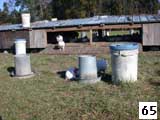 IraLoke Farm (Craig & Debbie Hardin, Salem, Florida) embodies much that is good and durable about this great nation and, indeed, Earth that we have a tenuous lease on. Part of an original Spanish land grant to a Mr. Wilder, IraLoke came into Hardin stewardship through Craig’s great uncle and ggrandfather on the Parker side. Now, Craig and Debbie pasture-finish beef and goats without the use of synthetic chemicals. They also raise free-range poultry (Slide 65) for meat and eggs on pasture that is supplemented by an organic balanced ration. (Incidentally, the meat chickens are processed in an approved facility and can be purchased directly from Craig.) Syrupmaking, though, is purely not-for-profit fellowship. When I visited, parents Thad and Iris Hardin (who live only a stone’s throw away), sister Leah with husband Ray Kellerman, and friends Michael and Lee Newman were gathered around the 60-gallon Kehoe kettle, which was supplied with juice by a nearby Goldens’ No. 27 (New Model). Close to tradition, the Hardins use a wood furnace and a kettle. They do not use a ring on their kettle, but keep the kettle rim scrupulously clean. In the end, their syrup is excellent, having the full favor that I expect of cane syrup. IraLoke Farm (Craig & Debbie Hardin, Salem, Florida) embodies much that is good and durable about this great nation and, indeed, Earth that we have a tenuous lease on. Part of an original Spanish land grant to a Mr. Wilder, IraLoke came into Hardin stewardship through Craig’s great uncle and ggrandfather on the Parker side. Now, Craig and Debbie pasture-finish beef and goats without the use of synthetic chemicals. They also raise free-range poultry (Slide 65) for meat and eggs on pasture that is supplemented by an organic balanced ration. (Incidentally, the meat chickens are processed in an approved facility and can be purchased directly from Craig.) Syrupmaking, though, is purely not-for-profit fellowship. When I visited, parents Thad and Iris Hardin (who live only a stone’s throw away), sister Leah with husband Ray Kellerman, and friends Michael and Lee Newman were gathered around the 60-gallon Kehoe kettle, which was supplied with juice by a nearby Goldens’ No. 27 (New Model). Close to tradition, the Hardins use a wood furnace and a kettle. They do not use a ring on their kettle, but keep the kettle rim scrupulously clean. In the end, their syrup is excellent, having the full favor that I expect of cane syrup.
I proudly point out that Gene Luke (Nashville, Georgia) and I go way back. One of a vanishing breed, Gene can make anything work and over the years, he has improved  my life in a number of ways such as by working on my tractor, building my mill stand, my kettle stand, bee-hive stands, you-name-it. His work now mostly focuses on building barbeque grills of his own design and I feel that I luck out when he takes in something for me, as much of a favor as a job. (It wouldn't be right if I mentioned that his real mechanical focus these days is the performance of fish hooks on the Altamaha . . . .) Gene grows cane for pleasure, for syrup and, on occasion, for profit. Like many who grow cane, he is interested in the antique equipment associated with cane and has some kettles and mills, particularly a Goldens' No. 1 (New Model) that he mechanized to run off a tractor pto. One day, I noticed this neat combination cane stripper-knife (Slide 66) in his shop. I had never seen one exactly like it and thus thought it would be of interest to share. my life in a number of ways such as by working on my tractor, building my mill stand, my kettle stand, bee-hive stands, you-name-it. His work now mostly focuses on building barbeque grills of his own design and I feel that I luck out when he takes in something for me, as much of a favor as a job. (It wouldn't be right if I mentioned that his real mechanical focus these days is the performance of fish hooks on the Altamaha . . . .) Gene grows cane for pleasure, for syrup and, on occasion, for profit. Like many who grow cane, he is interested in the antique equipment associated with cane and has some kettles and mills, particularly a Goldens' No. 1 (New Model) that he mechanized to run off a tractor pto. One day, I noticed this neat combination cane stripper-knife (Slide 66) in his shop. I had never seen one exactly like it and thus thought it would be of interest to share.
Richard Harrison (Altha, Florida) stands by this magnificent Goldens' No. 45 (New Model) and thus provides perspective of its large size. Goldens' belt-driven mills ranged in capacity from 150 to 600 gallons per hour and in power requirements from 5 to 30 HP. At this writing (May 2005), I have never seen a No. 63, the largest mill at 13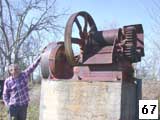 000 pounds. The No. 54 (7 900 pounds), the next size down, is rare, as is the No. 45 (Slide 67), which weighs 4 700 pounds. This particular mill was transported by two partners to its present location (Jackson County, Florida) in the 1970s from a nearby location to the southwest. The aim was to set up a sorghum operation to provide syrup to be packed by the now defunct Roddenbery Company (Cairo, Georgia). Seeing a photo of this mill reminded Anthony Brinson of a conversation that he had with Mr. Doyle Griner, who worked at the Cairo sugar-cane experimental station. Mr. Griner had been sent to a sorghum operation that was under contract with Roddenbery. In the end, his assistance still wasn't enough. The steep learning curve for making quality syrup (don't we all know about that!), bad weather, and low prices spelt the end, and the mill has not been used now for a quarter of a century. As an incidental point, I am not aware of extensive sweet sorghum plantings ever being made in this region and at present am only aware of one local operation, which is a joint hobby venture of my friends Zack Hicks and Leon Robinson. 000 pounds. The No. 54 (7 900 pounds), the next size down, is rare, as is the No. 45 (Slide 67), which weighs 4 700 pounds. This particular mill was transported by two partners to its present location (Jackson County, Florida) in the 1970s from a nearby location to the southwest. The aim was to set up a sorghum operation to provide syrup to be packed by the now defunct Roddenbery Company (Cairo, Georgia). Seeing a photo of this mill reminded Anthony Brinson of a conversation that he had with Mr. Doyle Griner, who worked at the Cairo sugar-cane experimental station. Mr. Griner had been sent to a sorghum operation that was under contract with Roddenbery. In the end, his assistance still wasn't enough. The steep learning curve for making quality syrup (don't we all know about that!), bad weather, and low prices spelt the end, and the mill has not been used now for a quarter of a century. As an incidental point, I am not aware of extensive sweet sorghum plantings ever being made in this region and at present am only aware of one local operation, which is a joint hobby venture of my friends Zack Hicks and Leon Robinson.
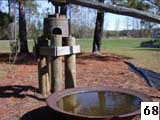 The essence of the 1920s in deep South Georgia is captured by this kettle and mill (Slide 68), which form the focal point at the entrance of the Rambling Rose, an outdoor emporium in my hometown (Nashville, Georgia). It is interesting that before the New Models, the foundry cast was "The Golden Mill . . ." and inside later catalogs one sees "Golden Cane Mills . . . ." However, on the New Model mills, the inscription is "Goldens' . . . ." In yet another rendition of the name, kettles such as the one here display the singular possessive, "Golden's . . . ." The essence of the 1920s in deep South Georgia is captured by this kettle and mill (Slide 68), which form the focal point at the entrance of the Rambling Rose, an outdoor emporium in my hometown (Nashville, Georgia). It is interesting that before the New Models, the foundry cast was "The Golden Mill . . ." and inside later catalogs one sees "Golden Cane Mills . . . ." However, on the New Model mills, the inscription is "Goldens' . . . ." In yet another rendition of the name, kettles such as the one here display the singular possessive, "Golden's . . . ."
In this supersize world, Beth and Tommy Clayton of Southern Cross Farms (also click here, Hilliard, Florida) can take on all comers. In addition to their "normal" 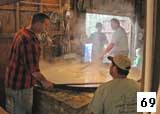 kettle, they cook on this monster (Slide 69), which hold 300 gallons (330 gallons up to the rim), weighs 3026 pounds, and is 2 1/4 inches thick! It takes 6-7 hours and 60-70 gallons of propane to make 30-35 gallons of syrup. Whew. Click here for more photos of the 2004 Festival that were provided by Tommy. kettle, they cook on this monster (Slide 69), which hold 300 gallons (330 gallons up to the rim), weighs 3026 pounds, and is 2 1/4 inches thick! It takes 6-7 hours and 60-70 gallons of propane to make 30-35 gallons of syrup. Whew. Click here for more photos of the 2004 Festival that were provided by Tommy.
Southern
Matters focuses on the Southeastern U.S., but it is good from time to time to 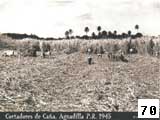 drop this shield of ethnocentricity and look afield. Sugar cane was obviously even more important to the islands than to the mainland, as this slide from Puerto Rico represents. This slide also represents goodness buried within people—it was a gift from an anonymous student. To whomever, thanks for sharing with us. drop this shield of ethnocentricity and look afield. Sugar cane was obviously even more important to the islands than to the mainland, as this slide from Puerto Rico represents. This slide also represents goodness buried within people—it was a gift from an anonymous student. To whomever, thanks for sharing with us.
Mr. Pete Smothers, a syrup maker from Balm,
Florida (south of Plant City), developed the automatic skimmer shown in Slide 71, with Charlie Kirksey manning the kettle. Essentially, the skimmer is a trough made of a <0.01-inch-mesh stainless-steel screen. The skimmer is mounted on a frame that sets on the ring and permits 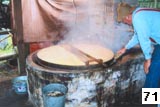 vertical adjustment in 1-inch increments. The nascent syrup boils over into the trough (or runs into the ends) and the skimmings are trapped by screen. The skimmer shown is used by the syrup-makers at the Pioneer Florida Village and Musuem (Dade City, Florida), and a closer view of the skimmer is shown by clicking here (with Melvin Brinson) or here and overviews of the syrup-making demonstrations and workshops are shown here (Wilber Dew in khaki) and here (with Charlie, again). The dimensions of the automatic skimmer are made to fit the kettle, with the one here being 7.5" w x 38" l x 2.5" d. Syrupmakers who are interested in fabricating the automatic skimmer will find these images of value: view of bottom1 , view of bottom2 , view of top1 , view of top2 , side view , skimmer end with notches , and washing skimmer. Using the same screen, they also use a manual skimmer (detailed view). (Special thanks to Melvin Brinson, Russell Henderson, and
Charlie Kirksey for sharing photographs and information .) vertical adjustment in 1-inch increments. The nascent syrup boils over into the trough (or runs into the ends) and the skimmings are trapped by screen. The skimmer shown is used by the syrup-makers at the Pioneer Florida Village and Musuem (Dade City, Florida), and a closer view of the skimmer is shown by clicking here (with Melvin Brinson) or here and overviews of the syrup-making demonstrations and workshops are shown here (Wilber Dew in khaki) and here (with Charlie, again). The dimensions of the automatic skimmer are made to fit the kettle, with the one here being 7.5" w x 38" l x 2.5" d. Syrupmakers who are interested in fabricating the automatic skimmer will find these images of value: view of bottom1 , view of bottom2 , view of top1 , view of top2 , side view , skimmer end with notches , and washing skimmer. Using the same screen, they also use a manual skimmer (detailed view). (Special thanks to Melvin Brinson, Russell Henderson, and
Charlie Kirksey for sharing photographs and information .)
The Chattanooga No.70 (Slide 72) is a small power mill (1000 lbs) that was manufactured over the brief period of 1908-1921. Presently (Spring, 2006), this little sister of the 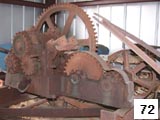 Chattanooga No. 45 is the only one that I have seen. The No. 44 series (44, 44A, 144, 144A), the 45 series (45, 45A, 145, 145A), and the No. 70 (as well as the No. 71, 171) were all based on a 9-inch diameter large roller and 6-inch diameter small rollers. Apparently, there were two versions of the No.70, and the new style (as I infer), shown here, used the same end plate as the 45 series whose production began in 1903 and with modifications made in '21, '22, '23, '24, '27, '29, and '33. Some other No.70 parts--such as the master gear and bearing boxes--were also interchangeable with those of the 45 series.These photographs were made in Boston ( Georgia) before the mill joined the Robinson-Hicks sorghum/sugarcane hobby operation in Capitola ( Florida). To see other views of this mill before restoration, click here, here, or here. In almost no time, Leon and Zack got busy and put this mill in good working order (see other side, noting fabricated gear guard). Restoration involved replacing a bearing and fabricating splash guards and assemblies, a weighted scraper, and a juice apron. The mill is powered by the pto of an 8N that goes through a double-tire friction drive to the pulley. In the end, a perfect and beautiful solution for their two-man operation! . . . our best wishes to them. Chattanooga No. 45 is the only one that I have seen. The No. 44 series (44, 44A, 144, 144A), the 45 series (45, 45A, 145, 145A), and the No. 70 (as well as the No. 71, 171) were all based on a 9-inch diameter large roller and 6-inch diameter small rollers. Apparently, there were two versions of the No.70, and the new style (as I infer), shown here, used the same end plate as the 45 series whose production began in 1903 and with modifications made in '21, '22, '23, '24, '27, '29, and '33. Some other No.70 parts--such as the master gear and bearing boxes--were also interchangeable with those of the 45 series.These photographs were made in Boston ( Georgia) before the mill joined the Robinson-Hicks sorghum/sugarcane hobby operation in Capitola ( Florida). To see other views of this mill before restoration, click here, here, or here. In almost no time, Leon and Zack got busy and put this mill in good working order (see other side, noting fabricated gear guard). Restoration involved replacing a bearing and fabricating splash guards and assemblies, a weighted scraper, and a juice apron. The mill is powered by the pto of an 8N that goes through a double-tire friction drive to the pulley. In the end, a perfect and beautiful solution for their two-man operation! . . . our best wishes to them.
Attention to detail, a keen eye and
perseverance
improve a person's luck, so it is no  surprise that Marcus Walker (Bonaire, Georgia) had the good luck to find a Chattanooga No. 45 in excellent condition though in need of restoration. Marcus took care of that detail (Slide 73; for the other side, click here; for the front, click here). Apparently made after 1921, this mill was equipped with a stamped-metal juice apron. Note that this mill has the original oiler assemblies, splash guards on the feed trough and counter-balancing rod for the scraper. What a mill! surprise that Marcus Walker (Bonaire, Georgia) had the good luck to find a Chattanooga No. 45 in excellent condition though in need of restoration. Marcus took care of that detail (Slide 73; for the other side, click here; for the front, click here). Apparently made after 1921, this mill was equipped with a stamped-metal juice apron. Note that this mill has the original oiler assemblies, splash guards on the feed trough and counter-balancing rod for the scraper. What a mill!
 A great find by Andy Palmer of Pavo (Georgia), this little gem (Slide 74) is a 20-gallon syrup kettle made by Goldens' . Weighing 110 pounds and being less than 3 feet across, it is the smallest syrup kettle made, to my knowledge. At this writing, it is the only one of this size that I have seen. A great find by Andy Palmer of Pavo (Georgia), this little gem (Slide 74) is a 20-gallon syrup kettle made by Goldens' . Weighing 110 pounds and being less than 3 feet across, it is the smallest syrup kettle made, to my knowledge. At this writing, it is the only one of this size that I have seen.
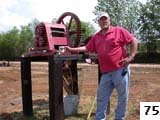
Jerome Bodiford (Hahira, Georgia) and his father-in-law, Ed Wilson, are setting up a hobby syrup operation based on this old-style Chattanooga No. 44 (Slide 75). They power it directly with an 11HP gas motor that runs on idle, providing enough power and proper rpm. The motor is mounted on a hinge so that the weight of the motor provides for belt tension.
|